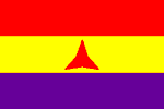Spain

Capitán Fernando Romero Tejero
Spain

Capitán Fernando Romero Tejero
Fernando Romero Tejero was born in Alcázar de San Juan, Ciudad Real, on 2 January 1904.
He joined the Arma de Aviación in July 1924 as a student mechanic at the Escuela at Cuatro Vientos, in Madrid.
He graduated in May 1925 and was posted to Escuadrilla AME VI, named after the aircraft it operated.
In June 1926 he transferred to a Loring R-I reconnaissance Escuadrilla based at Tetuán and Larache airfields, in Morocco.
In February 1927 the unit returned to Cuatro Vientos, and in September of the following year he was accepted into the Escuela Civil at Albacete.
Promoted to cabo in December 1928, he subsequently graduated as a piloto militar in March 1929 and was posted to León airfield.
Three months later he had his first experience of flying a fighter when he was posted to the Escuadrilla Martinsyde of the Grupo de Instrucción at Getafe.
He took part in an air-sea training exercise in the Mediterranean during this period.
In March 1930, came another posting, this time to Escuadrilla Breguet 19 of the same grupo, where he was promoted to sargento piloto in April.
In 1931, he returned to fighters, this time Ni-H.52s built locally at Getafe and issued to newly established Grupo No 13 based at El Prat de Llobregat.
The following year he took an aerial gunnery and bombardier’s course at Los Alcázares airfield, from which he graduated on 20 July.
In August, he was posted to Escuadra No 2 in Seville, joining Grupo No 22 equipped with Loring R-III reconnaissance aircraft.
In October 1932, he applied for a new posting, to the EscuadrillaY-2 at the Escuela de Tiro y Bombardeo at Los Alcázares, where he served until 1936.
In July 1936, a Nieuport fighter patrulla was established within Escuadrilla Y-2 at Los Alcázares. Teniente Aurelio Villimar assumed command of the unit and it included sargento Romero Tejero.
Aurelio Villimar was subsequently relieved by teniente Alarcón.
Romero Tejero played an active role in the capture of the seaplane base at La Ribera, in Murcia.
On 27 July, teniente Alarcón of the fighter patrulla of Escuadrilla Y-2 flew Ni-H.52 ‘3-87’ to Guadix, accompanied by sargento Romero Tejero in ‘3-24’.
Alarcón crashed on landing, suffering slight leg injuries. When replacement aircraft ‘3-42’, flown by sargento Ángel López Pastor, arrived overhead Guadix, it was attacked in error by Romero Tejero! Fortunately, López Pastor escaped unscathed.
On 28 July, sargento Romero Tejero of the fighter patrulla of Escuadrilla Y-2 flew Ni-H.52 ‘3-24’ to Andújar airfield, in Jaén, to escort two Breguet XIXs.
While based there he took off to intercept enemy aircraft, but engine failure caused him to force-land. Emerging from his wrecked fighter with both leg and eye injuries, Romero Tejero was admitted to hospital at Andújar and subsequently sent back to Los Alcazares on 30 July.
By 11 August he was again flying a Ni-H.52 from Guadix.
On 13 August, sargento Romero Tejero took off from Guadix with a Ni-H.52 and shot down two Nationalist Breguet XIXs. The first crashed at Venta Navas and the second at Pinos Puente.
Upon returning home, Romero Tejero was congratulated by both the local committee and the CO of Los Alcázares airfield, comandante Ortiz, who was making a tour of inspection at the time.
Romero Tejero continued flying Ni-H.52s and was involved in several combats during this period, including one with a CR.32 in the Iznalloz area of Granada.
He also undertook numerous patrol and reconnaissance sorties from Albacete, Valencia and Los Alcázares, as well as hazardous night flying even if he lacked nocturnal flying experience.
On 20 October, sargento Romero Tejero of the fighter patrulla of Escuadrilla Y-2 (Ni-H.52) took off on his own initiative to intercept enemy raiders on the night of 19/20 October. He engaged a Nationalist tri-motor (probably a Ju 52/3m) and watched it explode over the sea ten miles west of Cartagena naval base.
The claim was officially confirmed by comandante Ortiz.
In November 1936, he was promoted to teniente, having logged 80 sorties and 65 flying hours in Ni-H.52 fighters.
Having not fully recovered from his wounds after his crash landing on 30 July, he was withdrawn from frontline duties and posted to the Escuadrilla de Transportes, operating between Los Alcázares and Madrid.
On 29 December, teniente Romero Tejero of the Escuadrilla de Transportes was involved in a flying accident.
In early 1937, he was appointed secretary to the CO of Los Alcázares airfield and put in charge of the Oficina de Informatión y Cartografia.
Romero Tejero was promoted to capitán on 1 September 1938.
On 3 October 1938, capitán Romero Tejero was appointed CO of the 6o Sector Aéreo at Hellín, in Albacete.
In February 1939, capitán Romero Tejero became CO of the 3o Sector Aéreo at Los Llanos, again in Albacete.
He surrendered Los Llanos to Nationalist command at war’s end.
Romero Tejero ended the war with 3 biplane victories.
He was subsequently court-martialled and sentenced to 20 years imprisonment. No further data is available on him but it seems that he died on 1 July 1940.
Claims:
| Kill no. | Date | Time | Number | Type | Result | Plane type | Serial no. | Locality | Unit |
| 1936 | |||||||||
| 1 | 13/08/36 | 1 | Breguet XIX | Destroyed | Ni-H.52 | Venta Navas | Escuadrilla Y-2 | ||
| 2 | 13/08/36 | 1 | Breguet XIX | Destroyed | Ni-H.52 | Pinos Puente | Escuadrilla Y-2 | ||
| 3 | 20/10/36 | night | 1 | Ju 52/3m | Destroyed | Ni-H.52 | 10m W Cartagena naval base | Escuadrilla Y-2 |
Biplane victories: 3 destroyed.
TOTAL: 3 destroyed.
Sources:
Fighter Pilots Of The Spanish Republic (Vol. 1) - Rafael A. Permuy López, Historica 36/39 no. 1, ISBN 84-87314-89-9
Spanish Republican Aces – Rafael A Permuy López, 2012 Osprey Publishing, Oxford, ISBN 978-1-84908-668-4


